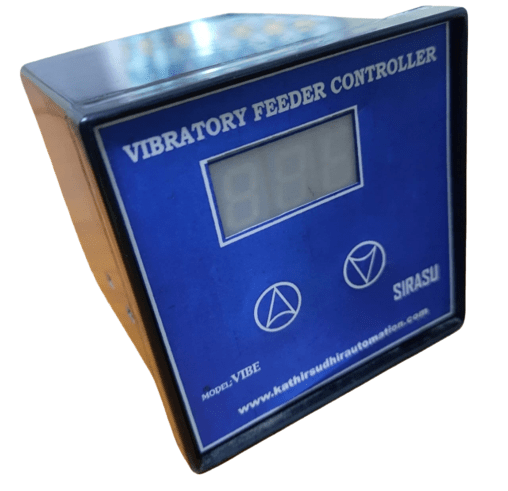Vibratory Feeder Controller meaning is an instrument used for vibratory smaller material from one position to another place of position. Vibratory linear feeder is mainly used for controlling the vibratory feeder in the system of automation. Vibratory linear feeder is used for small material to move in linear movement. Vibratory feeder controller operation works based on the controls of vibratory feeder to operate the movement with the vibrating feeders.

Vibratory feeder controller types : Analog vibratory feeder, Digital vibratory feeder.
Vibratory technical details are as follows:
Input:0-240V AC, Single Phase. Output : 0-90V DC / 0-110V AC. Current Rating: 3A-6A.Display:7 segment- 3 Digits (Digital Model only).Weight: 0.51 kg.
Vibratory feeder controller sale across India when you buy from us.
Vibratory feeder controller user manual is been updated in our website.
What is Vibratory Feeder:
They consist of a trough or a bowl that is mounted on springs or other dampening elements, and an electromagnetic or mechanical drive that generates vibrations. These vibrations cause the materials to move in a controlled and precise manner, allowing for accurate feeding, sorting, and orientation of the materials.
Types of Vibratory Feeders: There are various types of vibratory feeders available, each designed for specific applications. Some common types include:
- Electromagnetic Vibratory Feeders: These feeders use an electromagnetic drive to generate vibrations. The drive consists of a coil that is powered with an alternating current, creating a magnetic field that attracts and repels a magnet attached to the feeder tray, causing it to vibrate.
- Electromechanical Vibratory Feeders: These feeders use a mechanical drive, typically powered by an electric motor, to generate vibrations. The motor drives an eccentric weight that is attached to the feeder tray, creating vibrations that move the materials.
- Vibratory Bowl Feeders: These feeders consist of a bowl-shaped container that is typically made of stainless steel or plastic. The bowl is mounted on springs and vibrates using either an electromagnetic or electromechanical drive, causing the materials to move along the spiral or circular track of the bowl.
Applications of Vibratory Feeders: Vibratory feeders have a wide range of applications across various industries. Some common applications include:
Applications
- Material Handling: Vibratory feeders are used to transport and handle bulk materials such as minerals, ores, grains, chemicals, and plastics. They are used in mining, pharmaceuticals, food processing, packaging, and other industries to efficiently convey materials from one process to another.
- Sorting and Orientation: Vibratory feeders can be used to sort and orient materials based on their size, shape, or other properties. For example, in the automotive industry, vibratory feeders are used to sort and align small components such as screws, nuts, and bolts before assembly.
- Feeding and Packaging: Vibratory feeders are commonly used in packaging and filling applications to accurately dispense and feed materials into containers or packaging machines. They ensure precise dosing and prevent overfilling or spillage.
Benefits of Vibratory Feeders: Vibratory feeders offer several advantages over other types of feeding and conveying methods. Some key benefits include:
- High Efficiency: Vibratory feeders are highly efficient in conveying and handling bulk materials. The controlled vibrations allow for smooth and consistent movement of materials, reducing downtime and increasing productivity.
- Precise Feeding: Vibratory feeders provide precise and accurate feeding of materials, ensuring consistent dosing and preventing overfeeding or underfeeding. This makes them ideal for applications that require precise material handling.
- Flexibility: Vibratory feeders can be customized to suit specific requirements, such as the type and size of materials, desired feed rate, and orientation. They can be easily adjusted and fine-tuned to achieve optimal performance in various applications, For more product like this kindly visit our website https://homecarebed.in/

